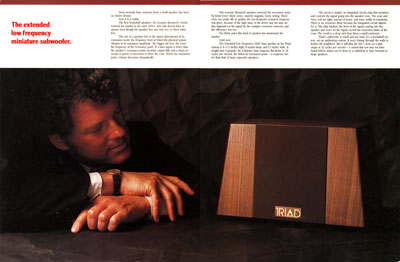The extended
low frequency miniature subwoofer.
Deep accurate bass response from a small speaker has been an elusive dream.
Now it is a reality.
The first bookshelf speakers (by Acoustic Research) revolutionized the market in the early 1950's: they had decent bass response even though the speaker box was only two or three cubic feet.
The size of a speaker box is the major determinant of its resonance point: the frequency level at which the physical system vibrates at its maximum amplitude. The bigger the box, the lower the frequency of the resonance point. If a bass signal is lower than the speaker's resonance point, acoustic output falls and a sharp increase in power is necessary to drive the cone. Below the resonance point, volume decreases dramatically.
The Acoustic Research speakers lowered the resonance point by brute force: thick cones, massive magnets, heavy wiring. There were two trade-offs in quality: the low-frequency transient response was poor, because of the high mass of the driver and the time delays imposed on the signal by the complex crossover network; and the efficiency was low.
For thirty years this kind of speaker has dominated the market.
Until now.
The Extended Low Frequency (ELF) bass speaker in the Triad system is 8-1/2 inches high, 8 inches deep, and 13 inches wide. It weighs just 9 pounds. Yet it delivers bass response flat down to 24 cycles per second, far below its resonance point - a response better than that of large expensive speakers.
The secret is simple: an integrated circuit chip that monitors and controls the signal going into the speaker cone. The cone and voice coil are light, instead of heavy, and react swiftly to transients. There is no crossover delay because the integrated circuit adjusts for it. The chip analyzes the level of the signal coming into the speaker and won't let the signal exceed the excursion limits of the cone. The result is a deep rich bass from a small enclosure.
Triad's subwoofer is small and not loud. It's a bookshelf system, not an auditorium system. It won't thump through the walls to bother the neighbors. But it will play the low C note on a pipe organ at 32 cycles per second - a sound that you may not have heard before unless you've been in a cathedral or have invested in large speakers. |
